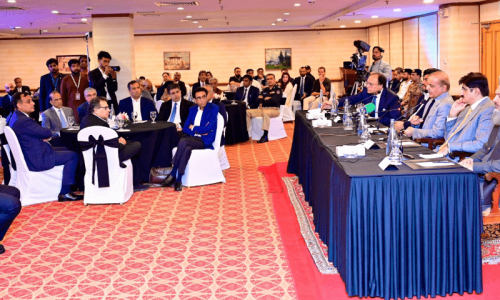 MUZAFFARABAD, Oct 17: Vital helicopter flights carrying food, blankets and tents to untold numbers of survivors of the earthquake in northern Pakistan resumed on Monday as lashing rains, which compounded their misery, ended.
MUZAFFARABAD, Oct 17: Vital helicopter flights carrying food, blankets and tents to untold numbers of survivors of the earthquake in northern Pakistan resumed on Monday as lashing rains, which compounded their misery, ended.
However, many are likely to die before help can reach them in the remnants of remote mountain villages cut off by landslides and buckled roads with winter approaching rapidly.
“We saw rows of people in a really bad way with suppurating wounds. They need urgent treatment,” Sean Keogh, a doctor with the British medical aid group Merlin, said after a three-day trek up the badly hit Neelum valley of Azad Kashmir.
“There are 1,000 to 2,000 significantly wounded that need surgical treatment,” he said. “Wounds are pouring puss, patients are going to get septic and die.”
With the valley’s road swept away by landslides, nobody knows how many people need help in its upper reaches north of Muzaffarabad, Keogh said.
“There are going to be a lot more deaths.”
The weather cleared nine days after the quake pulverised the mountains of Kashmir and North West Frontier Province (NWFP), allowing helicopters, the only means of getting aid to many of the traumatised survivors quickly, to take off.
One brought a couple of dozen badly injured people back to Islamabad from the upper Jhelum valley to be rushed to hospital.
Mohammed Fayaz, a 23-year-old garment factory worker arrived from Chakoti cradling his injured toddler nephew.
“The last few days were very terrible. We had no food and no shelter at night,” he said.
HELCOPTER, TENT SHORTAGE: There are still not enough helicopters. Tents, despite a spate of contributions from abroad, are still in short supply with the lowest estimate of the number of people who lost everything in the Oct 8 quake at one million.
Nearly 40,000 people were killed in Pakistan and 65,000 injured. Another 1,300 were killed in held Kashmir.
Many of the survivors were under only the flimsiest of shelters on Sunday, when heavy rain grounded most relief flights.
Mules, horses and donkeys were also trying to get aid into areas of the NWFP and the Neelum and Jhelum valleys.
“You can go in any direction and paint a dire picture,” said Robert Holden, head of the UN disaster relief operation.
“The scale seems to be growing and the humanitarian lifeline is very thin,” he said. “The things going against us are the weather and the supplies not coming quickly enough.”
A steady trickle of people, despairing of help reaching them and some carrying the injured, continued to emerge from the hills, sometimes after days of trekking, overwhelming hospitals where doctors were working around the clock.
All too often, they are being obliged to amputate limbs after broken bones untreated for too long turned gangrenous and the confirmed death toll is expected to rise substantially.
NO EPIDEMICS YET: There are also fears of disease from ruined sewage systems and drinking water sources, but Health Minister Mohammad Naseer Khan told Reuters vaccination teams were fanning out to innoculate people against diseases such as cholera and tetanus.
There were no signs yet of epidemics, he said. “To date, I think, praise to God, we have, fortunately, no signs, but we are constantly monitoring because that is the key thing till we clear off the debris and bury the bodies.”
The government appealed for doctors to fly in to help and the US army was preparing to dispatch a MASH (Mobile Army Surgical Hospital) unit from Germany. “We are ready to go and our soldiers are excited to help the Pakistani people,” Colonel Angel Lugo said at Ramstein Air Base.
The Pakistani military is also starting a village-to-village survey to try to get a more accurate assessment of casualties.
A pilot of one of the US helicopters dispatched from the fight against the Taliban in neighbouring Afghanistan said some Kashmir villages looked normal from the air, but consisted only of intact roofs lying on the ground.—Reuters















































Dear visitor, the comments section is undergoing an overhaul and will return soon.